Researcher: Youngbin Kim
Start date: 03.04.2014
End date: 28.08.2014
Overview
Sik-hae is a Korean traditional fermented fish product with flounder, cooked grain, red chili powder, garlic, and sometimes with vegetables and malt extract. I experimented with developing a similar technique for flounder here in Denmark. I used a mixture of cracked barley and cracked rye for the cooked grains, horseradish and garlic for spicing, and 10% salt of the whole weight of fish for initial salting treatment. The final result is versatile, for example providing a different topping for the classic Danish smørrebrød.
Sik-hae is a Korean traditional fermented fish product with cooked grain, red chili powder, garlic, and sometimes with vegetables and malt extract. In Korean, it is written as ‘식해’, which could be written in Chinese as ’食醢’. ‘食’ means ‘eat’ or ‘grains’ and ‘醢’ means ‘salted or fermented seafood’ (Lee & Cho, 2004). This type of seafood fermentation originates from South East Asia (Thailand, Laos, Myanmar) where fish is abundant and the staple is rice (Lee, 1983).
Fermenting seafood provides a way to preserve it and gain stable access to a protein source, and this fermenting technique for proteinous substrates needs less salt than some others which helped to save expensive salt in these regions (The Academy of Korean Studies). In addition, it fits well with plain rice as a salty side dish.
It is believed that fish fermentation with cooked grains was introduced through China to Korea, where it came to be made with red chili powder, possibly to have similar properties as Kimchi (Lee, 1983). The Korean province of Ham-Kyung on the north-east coast of the Korean peninsula is the most famous area for Sik-hae, where it is typically made with small flounder and cooked millet (Suh, 1987). Due to the local climate conditions, fish was available all year though it was a challenge to maintain a constant supply of salt. Therefore cooked millet was used to reduce the amount of salt needed to preserve the fish (Suh, 1987).
Millet is the most typical grain with which to make Sik-hae in Korea, however rice or a mixture of rice and millet is also used in southern areas (Suh, 1987). Flat fish are the most common types of fish used to make Sik-hae, though other types of fish such as cod, pollack and hairtail can be also used, and even octopus and squid are used in some parts of Korea (Suh, 1987).
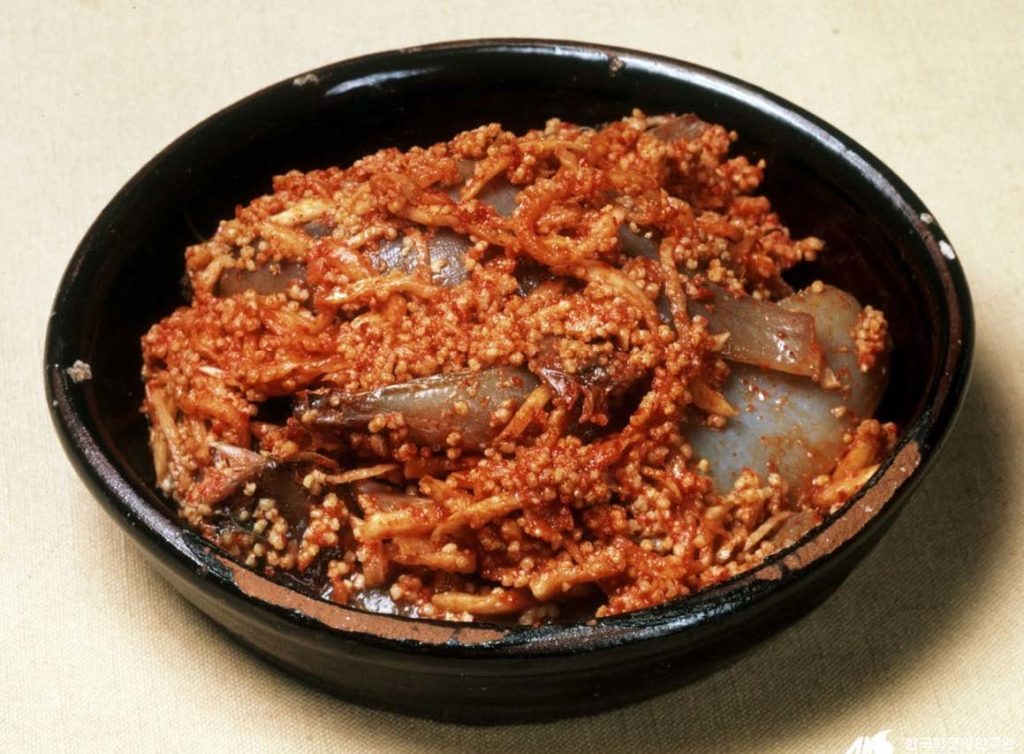
Lactic acid bacteria (LAB) and the enzymes on and in the fish begin the fermentation process (Lee & Cho, 2004). Cooked grain is a source of carbohydrates for LAB and as the fermentation develops lactic acid increases which lowers pH and prevents spoilage (Katz, 2012). Malt extract is also added in some areas in Korea and plays a role in saccharifying the cooked grains so that the LAB gain more access to these nutrients and the fermentation progresses more quickly. Fermentation temperature differs by region, but occurs mostly around 15-20°C (Lee & Cho, 2004). In general, the fermentation takes around 5-7 days, at which point it can be stored in the fridge to keep from becoming too strong.
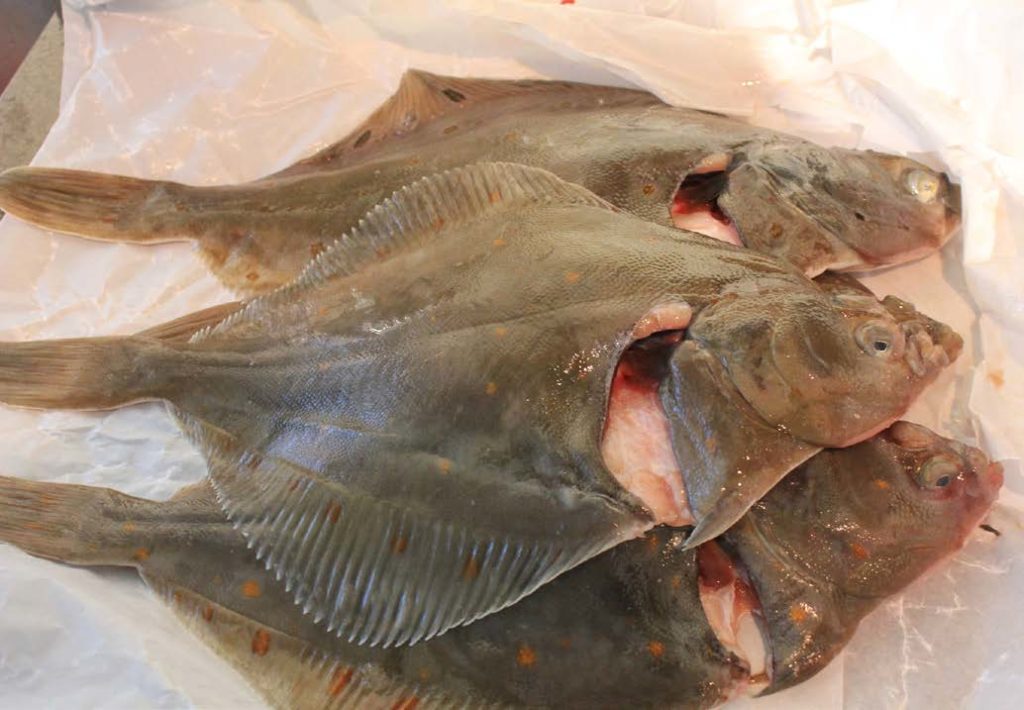
To explore new tastes from fish fermentation beyond just pickling in vinegar, and since flounder is an abundant flatfish in Denmark, I began to ferment these flounders with this Korean fish fermentation technique.
However, it was quite tricky to find the proper salt level, the time for salting the fish in the first treatment, the proportion of fish, grains, other ingredients, and the ideal substitutes for millet, chili powder and ginger. The recipes I could find in Korean references were very different from each other, so it was hard to compromise. Therefore, to figure out these essential questions, I tried several experiments mainly differing in salt amount, type of grains, and the addition of spicing. The proportion of all ingredients was adjusted in each prototype but it didn’t change a lot from the first trial.

For the final recipe, I used a mixture of cracked barley and cracked rye for the cooked grains, horseradish and garlic for spicing, and 10% salt of the whole weight of fish for initial salting treatment.
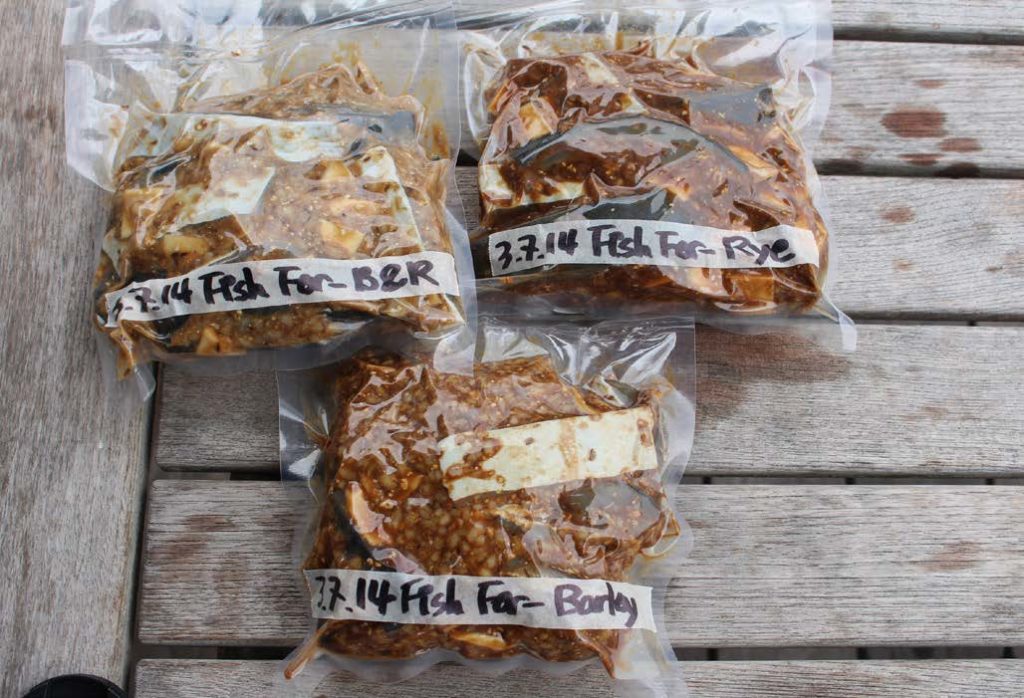
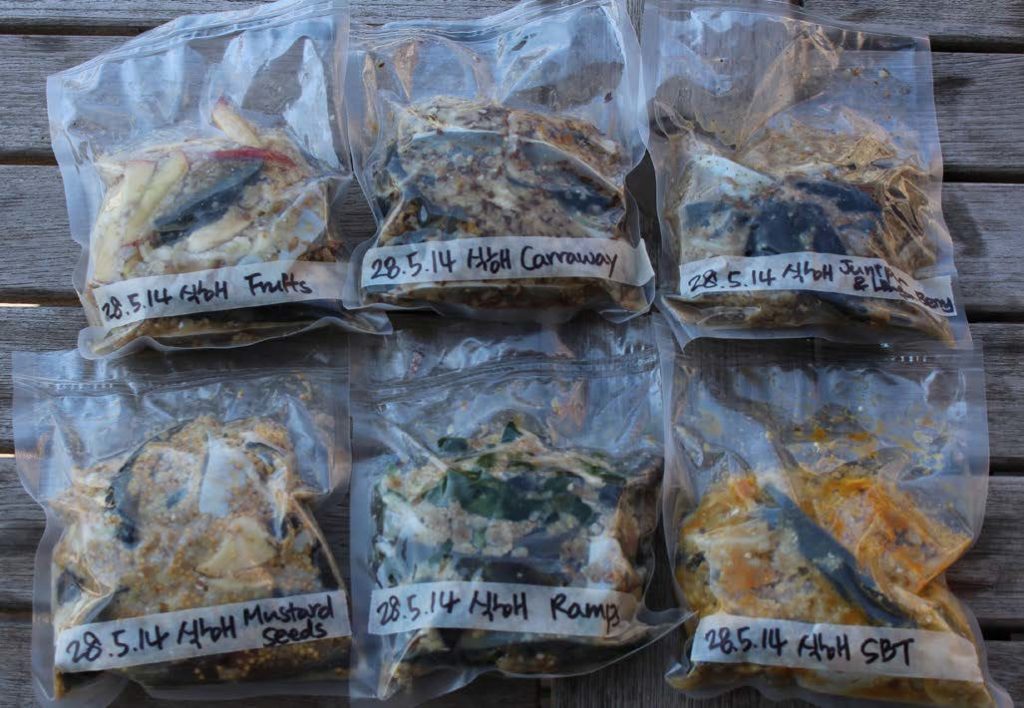
‘Nordic’ Sik-hae
1. Remove the head and organs of the flounders, and salt them whole for about 24 hours with 10% salt of the fish weight.
2. Wash off the salt from the fish and cut into pieces (4-5 pieces per each flounder), then dry for 3-4 hours in direct sunlight.
3. Boil cracked barley and cracked rye separately in water until they get like firm boiled rice.
4. Prepare all the ingredients:
600g fish, after being salted and sun-dried
100g cooked cracked barley
100g cooked cracked rye
100g ground vegetables (20g of each of garlic, ginger, onion, apple, pear. Grind with thermo-mix until it becomes a puree)
70g horseradish
10g malt extract
10g barley malt
10g caraway
5. Mix all the ingredients with the fish and seal in the vacuum bag. Store for more than 7 days in cool temperature (about 8-12°C) without direct sunlight, then move to the fridge (4-6°C)
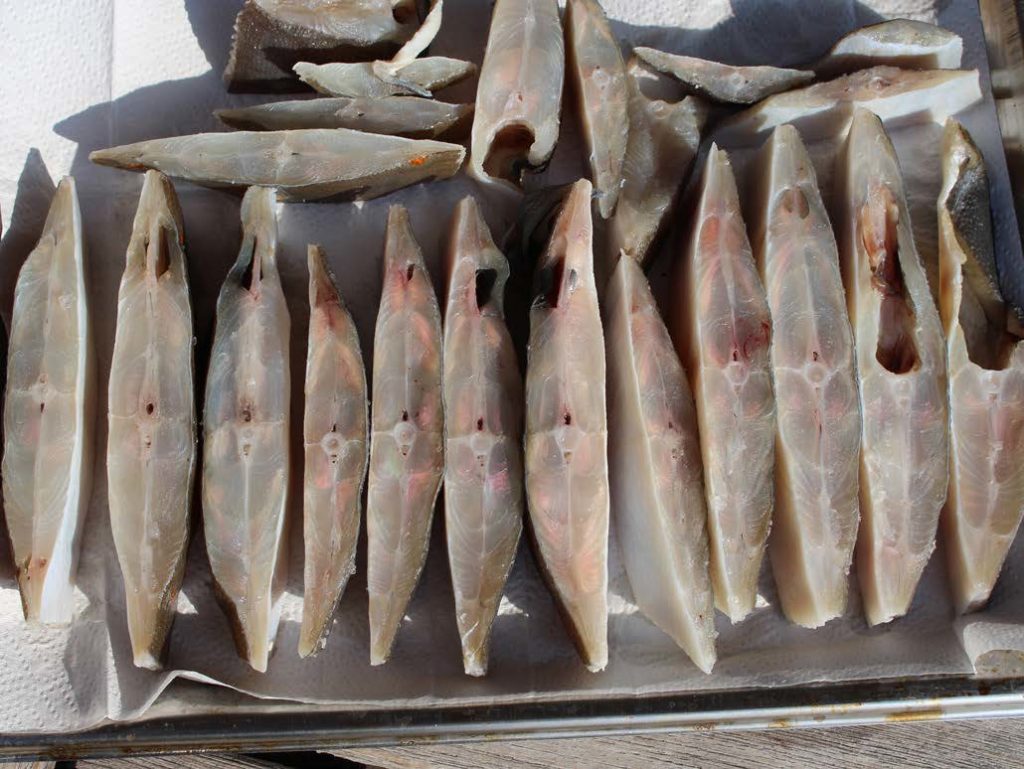
Caraway can be substituted by other spices depends on one’s preference. Among several trials, mustard seeds and white pepper were also good and harmonized well with the horseradish flavour.
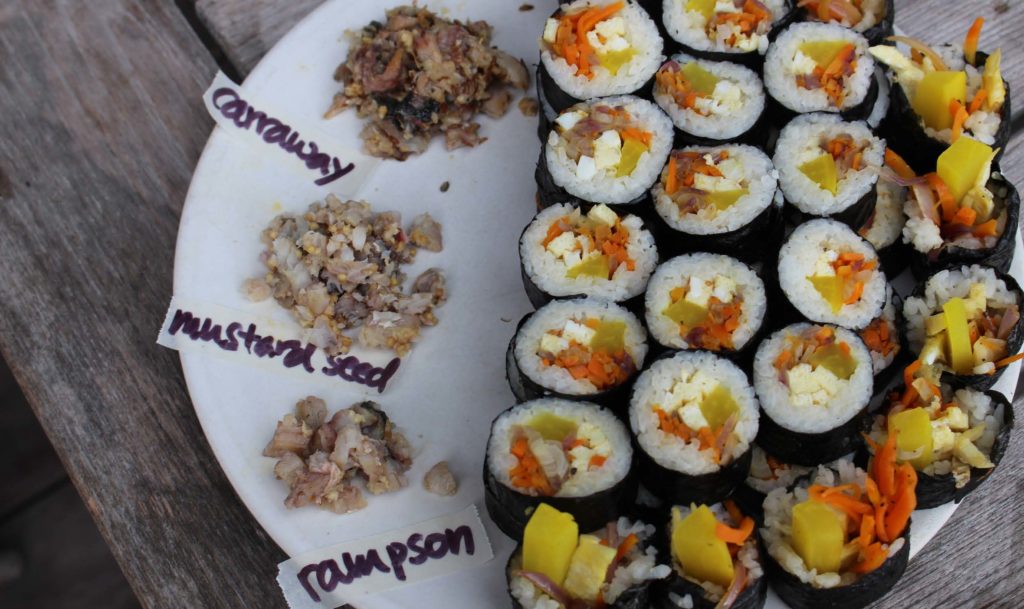
The overall taste of the fermented fish is sour, kind of sweet, and refreshing from the horseradish and caraway. It is very savory so that it fits as a snack or meal with rice or bread. The texture gets softer as time goes on. Fermenting for 3-4 weeks gave the most interesting and enjoyable taste and texture. In Korea, we eat it raw as a cold side dish, but the Nordic version tasted too raw to eat as it was. We cooked the pieces of fish in a pan with a small amount of vegetable oil. It was very good, crispy outside and soft and moist inside with harmonized horseradish and caraway flavour.
Once we had a Danish visitor on the boat – she tasted this Nordic Sik-hae and said she could imagine eating it with a slice of rye bread like pickled herring. So, I tried several times to make a dish inspired by ‘smørrebrød’, the Danish traditional open-faced sandwiches. One day for lunch we used the pan-fried sik-hae flounder to top some smørrebrød, along with kimchi made with turnip and sand leek, fresh puffball mushrooms brushed with mackerel garum, a few sand leek seeds, crème fraîche and dill. There was a balance between the sour and fermented fish flavour, the crisp fish skin, freshness from kimchi, fresh savouriness from the mushroom and round creamy flavours from the crème fraîche.
I can also imagine eating little bit of cooked Nordic Sik-hae on top of Kimbap which could taste similar to sushi. But for this there should be further investigations for balancing the flavours.
Different types of Sik-hae with Kimbap
Reference
Katz, S. E. (2012), The Art of Fermentation, Ch.12 Fermenting Meat, Fish, and Eggs, p.355-356, Chelsea Green Publishing, United States of America
Lee, C. H., Cho, T. S., Lim, M. H., Kang, J. W., Yang, H. C. (1983), Studies on the Sik-hae Fermentation Made by Flat-fish, Kor. J. Appl. Microbiol. Bioeng., Vol. 11, No.1, 53-58
Lee, M. W., Cho, K. Y. (2004), Salted fish, Part 6. p.104-106, Gimmyoung-sa, Paju, Korea
Suh, H. K. (1987), A study on the Regional Characteristics of Korean Chotgal – the ways of preservation of chotgal – , Kor. J. Diet. Culture., Vol.2, No.2
The Academy of Korean Studies (한국민족문화대백과), online terminology search, http://terms.naver.com/entry.nhn?docId=559876&cid=46672&categoryId=46672, accessed on 6th Aug 2014
